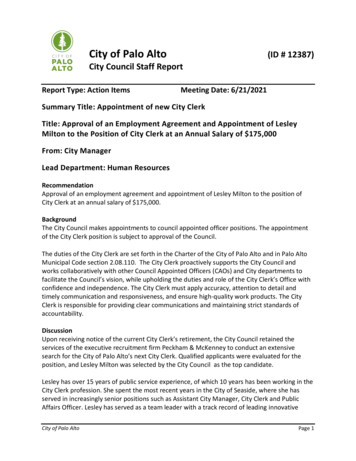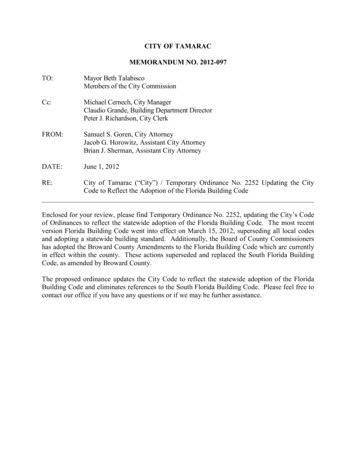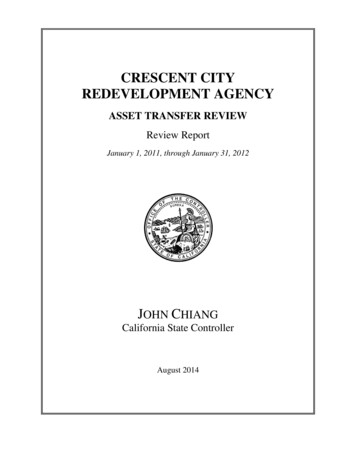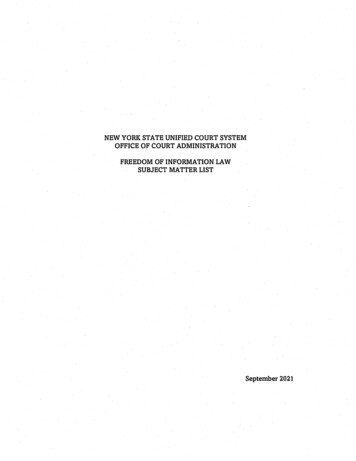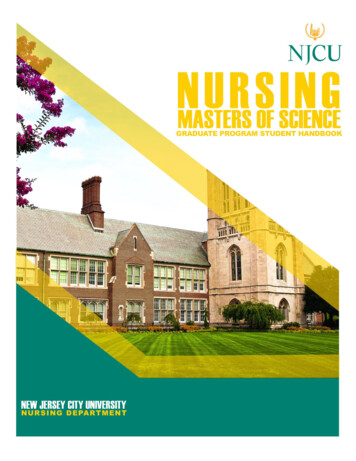
Transcription
I-B-7THE CITY UNIVERSITY OF NEW YORKAppointment of Dr. Naresh Devineni with Early Tenure at City CollegeWHEREAS, Dr. Naresh Devineni, Associate Professor of Civil Engineering at City College,focuses his research on advancing the science of risk management, and water resources planningin particular, andWHEREAS, Dr. Devineni’s research is critical to addressing pressing global challenges as thedistribution of water supply across the globe and the impact of climate on these challenges, andWHEREAS, Dr. Devineni has an exceptionally strong scholarly record, and record of receivinggrants from prestigious organizations such as the National Science Foundation, the Departmentof Energy, and the Environmental Protection Agency, be itRESOLVED, that Dr. Naresh Devineni, Associate Professor of Civil Engineering at CityCollege, be appointed with early tenure through a waiver of University Bylaw 6.2(d).EXPLANATION: The focus of Naresh Devineni’s research is advancing the science of riskmanagement with applications to water resources planning. His research is critical to suchpressing global challenges as the varying distribution of water supply across the globe and theimpact of climate risks on these. In four years, he has been awarded 1,296,894 in funding for12 projects, from such prestigious organizations as the Department of Energy, the NationalScience Foundation and the Environmental Protection Agency. His scholarly record isexceptionally strong and includes 33 peer reviewed journal publications. External reviews ofDr. Devineni’s scholarship are exceptionally complimentary. Dr. Devineni is by all accounts anenergetic, enthusiastic and dedicated teacher and mentor of students from high school to doctorallevels, and good citizen of his department and school and deserving of being awarded earlytenure.
Form OAA.2010.3 p. 103/2010Request for Faculty Personnel Action with a Bylaw WaiverDate August 23, 2018College or Unit The City College of New YorkName of Candidate Naresh DevineniDepartment Civil EngineeringAppointment Title Associate ProfessorFull-Time Tenured Full-Time Tenure Track XVisiting Substitute AdjunctDate of Initial Appointment 8/27/2013Summary of Action Early TenureBy-law to be waived/applied Section 6.2d of the University BylawsWaiver requested for (please check one):Appointment Promotion Re-appointment with Tenure XDate of Departmental P&B April 12, 2018Date of College-wide P&B April 25, 2018Waiver effective as of (starting date) September 1, 2018I hereby certify that this request for a waiver of the Bylaws is for the good of the institution.Please see attached(President’s/Provost’s signature)Vincent Boudreau, President(President’s/Provost’s name, typed or printed)
Form OAA.2010.3 p. 203/2010WAIVER JUSTIFICATIONName:Naresh DevineniUnit/College: City CollegeDepartment: Civil EngineeringPlease summarize your justification for requesting a waiver. Give examples of the candidate’s publications, quality ofteaching, honors, service and other achievements. You are encouraged to use only the space provided on this templatebut may add a second page if needed, particularly in the case of a justification for early tenure.Please see attached.Attach the Request Form; candidate’s CV; outcome of all P & B meetings; candidate’s personal statement; summary ofstudent course evaluations; peer reviews; if part of your normal tenure review process, a list of outside referees, withthose selected by the department marked with an asterisk and letters from outside referees; and any other relevantinformation. Please send in a format compatible with Word for Windows 2003. Email these materials toKenneth.Norz@mail.cuny.edu.
Wille Administration Building, Room 300160 Convent AvenueNew York, New York 10031OFFICE OFTHE PRESIDENTTEL: 212.650.7285FAX: 212.650.7680www.ccny.cuny.eduAugust 23, 2018Dr. Vita RabinowitzExecutive Vice Chancellor and University ProvostAcademic AffairsThe City University of New York205 East 42"d Street, 9th FloorNew York, NY 10017Dear Executive Vice Chancellor Rabinowitz:I write to request your approval to grant Dr. Naresh Devineni early tenure as an Associate Professor inthe Civil Engineering Department, effective 9/1/2018, as permitted under section 6.2.d of theUniversity Bylaws. Dr. Devineni is currently in his fifth year of service. His reappointment with earlytenure has been recommended by the Department Executive Committee, Divisional P&B, and theCollege-WideReview Committee.For your review, I have enclosed Dr. Devineni curriculum vitae. I fully endorse this recommendation.Thank you for your consideration of this request.CC: John Siderakis, Assistant Vice President of Human ResourcesVB/els
Wille Administration BuildingRoom 305160 Convent AvenueNew York, NY 10031TEL: 212.650.6638FAX: 212.650.6425OFFICE OF THE SENIOR VICE PRESIDENTFOR ACADEMIC AFFAIRS AND PROVOSTAugust 29, 2018President Vincent BoudreauThe City College of New York160 Convent AvenueNew York, NY 10031Re:Support for Early Tenure – Dr. Naresh DevineniDear President Boudreau:I write to offer my very strong support for reappointment with early tenure for Dr. Naresh Devineni whois also being recommended for promotion to Associate Professor in the Department of Civil Engineering.Dr. Devineni received his PhD in Civil Engineering from the University of Illinois in 2010, and was apost-doctoral Research Scientist and an Associate Research Scientist at the Columbia Water Center, EarthInstitute (2010-2013) prior to coming to The City College of New York in 2013. Dr. Devineni’soutstanding research record in the field of water resources analytics as well as his innovative teaching andextensive mentoring led him to be recommended for this distinction in a department known for itsespecially rigorous standards.Research and Scholarship:The focus of Dr. Devineni’s research is advancing the science of risk management with applications towater resources planning. His research is critical to such pressing global challenges as the varyingdistribution of water supply across the globe and the impact of climate risks on these. With a particularstrength in predictive data analytics, he has developed a body of knowledge in Dynamic Risk Analysisfor water management and environment sustainability. Practical applications of his research haveincluded helping to develop on-line tools for companies and users to understand their water risks andprioritize actions toward sustainable water management. In four years, he has been awarded 1,296,894in funding for 12 projects, from such prestigious organizations as the Department of Energy, theNational Science Foundation and the Environmental Protection Agency. His publication record isexceptionally strong with 33 peer reviewed journal publications (22 at CCNY) and an H-Index of 14with 553 overall citations. He has given 75 conference presentations (50 while at CCNY) and given 26invited talks (19 while at CCNY). He reached an even greater audience through blog he created in 2017to make data analysis easier for a broad population. Currently, dataanalysisclassroom.com has 12,000users across the globe and receives an average of 7500 view per month. Professor Casey Brown of theUniversity of Amherst writes of the blog: “I have read several entries or ‘lessons’ and they areingeniously illustrated with wonderful visualizations and clear explanations. . . .This is a wonderfulcontribution to society at large and I commend the effort he has put forth on it.” The extraordinarilybroad impact of his work for a scholar at his career stage was recognized with the prestigious Early1
Career Award from the Department of Energy in 2017 among a shower of other recognitions. ProfessorRichard Vogel of Tufts University writes: “I am quite confident that he is on a steady course to becomeone of the future leaders of our profession of hydrology. Among his own peer group, and using my 35years of experience as a professor, I can confidently say that Dr. Devineni is, already, among the mostproductive and successful scholars of his generation.” Professor Prof. Vijay P. Singh, DistinguishedChair Prof., Texas A&M, affirms: “I believe he is a rising star and is filled with exciting future promise.In the years ahead he will continue to make a name for himself as well as CUNY and will contribute tosustaining the rich culture of excellence that CUNY is worldwide known for.”Service and Teaching:Dr. Devineni is by all accounts an energetic, enthusiastic and dedicated teacher and mentor of studentsfrom high school to doctoral levels, and good citizen of his department and school. His didacticaspirations to make complex concepts accessible to broad audiences, as evidenced by his blog, arevaluable assets for advancing the College’s mission, especially as a premiere STEM institution inCUNY and New York City. One of his peer teaching evaluators notes: “his expertise and desire tobecome an excellent teacher has resulted in an impressive collection of material, sample problems,research topics which together would ultimately result in the publication of a textbook.” His professionaland college service include guest editing two journals, serving on NSF panels, and PhD advisorycommittees within and outside the department, as well as contributing his web expertise to thedepartment’s website management committee.Conclusion:Dr. Devineni is an exceptionally accomplished and versatile young scholar with no signs of slowing down.He is likely to become a leader among the global community researching solutions to some of the mostcritical environmental challenges facing the planet today. He is a valued member of the Civil EngineeringDepartment and a dedicated, innovative educator. He is a credit to City College and to CUNY. He has mystrongest support for early tenure and promotion to Associate Professor.Best Regards,Tony M. Liss, PhDInterim Provost & Senior Vice President for Academic Affairscc:Assistant Vice President John Siderakis, Office of Human Resources2
SummaryI have been a tenure-track Assistant Professor in the Department of Civil Engineering (CE) atthe City College of New York (CCNY) since September 2013. At CCNY, I also serve as afaculty affiliate of the NOAA and CUNY Cooperative Remote Sensing Science and TechnologyCenter (NOAA-CREST and CUNY-CREST). I created the Water Analytics research group thatfocuses on modeling of water systems and developing integrated risk hedging methods usingmulti-scale climate information. For the last four years, I have been conducting state-of-the-artresearch in hydro-climate modeling and extremes analysis, statistical methods, watersustainability and risk assessment and water systems analysis. My unique combination of water,climate, and multi-scale risk management expertise, and evident growth in scholarlyachievements made me a distinguished member of the scientific community at a very early stage.I created a body of knowledge in Dynamic Risk Analysis for water management andenvironmental sustainability that integrates intellectual, practical and educational elements. Iformed several national and international collaborations with researchers across universities.This is reflecting in my publication records and my grantsmanship. I have led the exploration,development, and application of new statistical and numerical methods to water-climateproblems and am advancing the thinking in climate-informed water sustainability. Mycontributions cover new algorithms for the assessment of water stress, modeling causality andspatiotemporal dependence in hydroclimate fields, innovations in tree-ring based reconstruction,hypothesis-driven approaches to trend identification and optimization to address water stress. Ihave also created Bayesian methods to reduce model and prediction uncertainties.Thus far, based on my research, I have co-authors 33 peer-reviewed journal articles (22 ofthem while at CCNY), one book chapter, one full dataset, 14 opinion articles and white papersand 75 conference presentations (50 of them while at CCNY). Besides, I have five pendingpublications under first round revision or peer-review. As per Google Scholar citation index, Ihave an H-index of 13, and my research articles have been cited 530 times. I have been invitedas a panelist and speaker for 26 important panel discussions and meetings at international,domestic and university-wide conferences (19 of them while at CCNY). Over the last fouryears, there is a significant uptrend in the number of citations I received for my research articles,indicating growing scholarly recognition among the scientific community.My research has been supported by grants from major U.S. federal agencies like Departmentof Energy’s Office of Science (DOE), National Science Foundation (NSF), National Oceanic andAtmospheric Administration (NOAA), Regional Transportation Center (UTRC), UniversityResearch Foundation (RFCUNY) and OAKRIDGE National Labs (ORAU). Currently, I havethree funded projects as PI and Co-PI. Two of them are from DOE (Early CAREER) and NSF.This is in addition to the nine completed projects in the last four years. Together, these 12projects account for a cumulative funding of 1,296,894 over four years.These projects have allowed me to support four Ph.D. students and four undergraduatestudents. Elius Etienne, one of these four Ph.D. students, has recently graduated and iscurrently working as a Water Systems Engineer at Gedeon GRC Consulting. I also co-advisethree other NOAA CREST Ph.D. students. I am a member of several Ph.D. advisorycommittees within and outside the department. I have developed a broad network of1 of 14
collaborations both in the USA and abroad, including co-advising doctoral students in HohaiChina and Drexel Universities.I teach four courses, CE 264 (Civil Engineering Data Analysis), CE 316 (Civil EngineeringDecision and Systems Analysis), G9100 (Water Resources Systems Analysis) and H1101(Advanced Data Analysis) in the CE department. I also conduct summer boot camp sessions onstatistics and water management for high school students as part of the CREST’s High Schoolprogram. I am very dedicated to teaching and always put students first. In my teaching, I usethe pedagogy of “active learning” (creating inquiry and scenario-based problem-solvingenvironments and organizing students into cooperative learning groups) to drive the character ofSTEM experience. My teaching evaluations are excellent in all categories. In addition totraditional university classroom teaching, I also actively participate in sharing my knowledge to abroader audience through social media. In this regards, very recently, I have created a datascience blog http://www.dataanalysisclassroom.com where people of all backgrounds and agescan learn data analysis, probability, and statistics in a fun and intuitive way without the technicallingo. The blog currently has 12000 users from across the world and receives an average of 7500page views per month.I serve as a reviewer for the most prestigious journals such as Nature Scientific Reports,Water Resources Research, Journal of Hydrology, Journal of Hydrometeorology, ASCE'sJournal of Water Resources Planning and Management, Journal of Water and Climate, Journal ofAmerican Water Resources Association, Hydrology and Earth System Sciences and ClimateDynamics. My reputation in water risk assessment has also led to an invitation to serve on theScientific Committee of the Fresh Water Health Index. I am currently acting as a guest editorfor Earth System Dynamics journal, and have acted as a guest editor for KSCE Hydrologicjournal in the past. I also served as a reviewer for NSF (both in panels and as adhoc).I have been honored with several scholarly and professional awards including, the prestigiousEarly CAREER Award from the Department of Energy in 2017, the Ralph E. Powe JuniorFaculty Award by Oakridge Associated Universities in 2016, and the CUNY Recognition forOutstanding Scholars Achievements in 2015 and 2014. I was also the sole nominee fromCCNY for the prestigious national Blavatnik Award for Young Scientists. In addition to theseawards, the student design team that I mentored won First Place in EPA’s Nationalcompetition for campus rainworks challenge in 2016. I have demonstrated recognition at CUNYand within the national and international communities of scholars.I firmly believe that I have exceptional skills to contribute to the field and become asuccessful faculty participating in the development of my Department, School of Engineeringand the University.2 of 14
Research InitiativeI created the Water Analytics research group at CCNY that focuses on modeling of watersystems and developing integrated risk hedging methods using multi-scale climate information.In the Water Analytics Group, my research team works on a domain of issues related toHydrology and Water Resources Management that require rigorous systems based inquiry andinvolve methodical uncertainties quantification. Large scale matters in hydroclimatology andtheir relations to oceanic, atmospheric, and land surface conditions and issues of global andregional water sustainability form the crux of our research.OverviewThe importance of climate variability and change on water resources is now well established,and this is perhaps the most significant factor on human vulnerability to climate. The ability tomake precise predictions about this detrimental risk is challenging. This is especially true whenhuman populations, land use change, and other factors are also affecting water futures. Ensuringwater sustainability is a major challenge for the coming decades, particularly in the face ofurbanization, industrialization and a rapidly growing global population. My work addresses thissignificant area, exploring water risks, floods and droughts, their climate determinants overmultiple centuries, and how these may affect interlinked human activities at various scales ofcities, river basins, and nations. As the Principal Investigation (PI) of federal, regional anduniversity-funded research projects, I am leading the exploration, development, and applicationof new statistical and numerical methods to water-climate problems. My research is focused onDynamic Risk Analysis for Water and Environmental Management. Dynamic Risk is the riskthat changes with time, due to natural or anthropogenic factors and evolving social priorities.Dynamic Risk Management (DRM) is a formal approach to adaptation to such changes. DRMframework will assess the risk exposure of water systems in a time-varying manner conditionalon factors that lead to either cyclical or monotonic change. It also factors in, the changes inexposure to risk given societal adaptation and mitigation actions. I created an integrated strategyfor estimation, prediction and decision support at different lead times to support adaptive riskmanagement. A probabilistic framework using Bayesian methods is used to address modeling3 of 14
and informational uncertainties, and to facilitate quantitative decision-making. I am nowfocusing on understanding decadal to multi-decadal hydroclimatic variability using observed andpaleo streamflow records and future climate projections, and combining them with adaptationactions to inform infrastructure investments and periodically update sectoral and interstateallocation rules. It will provide a capacity to assess the implications of climate, policy, waterdemand, water conservation and infrastructure development scenarios on socio-economic andwater outcomes. I made fundamental contributions in the following areas of research.Water Sustainability and Risk AssessmentSignificanceWater scarcity is a concern for the sustainability of life and human societies. The varyingdistribution of water supply across the globe involves complex patterns of rainfall in space andtime that directly influence ecosystems and the dependent infrastructure. Today many countriesare facing severe and persistent water resources crisis owing to a growing imbalance of supplyand demand. The simultaneous effects of agricultural growth, industrialization, and urbanizationcoupled with declining surface and groundwater quantity, regional water disputes, andinefficiencies in water use practices are some of the crucial problems facing the water sectorsglobally. The effects of climate variability and change, including increasing frequency ofextreme phenomena (e.g., droughts and floods) are also creating pressures on scarce watersupplies. As water bodies go dry, there is an increasing threat to food self-sufficiency andsustainability across the world. We are at the juncture where future water sustainability is underquestion with growing concerns as to the reliable supply of water for various needs. High interannual rainfall variability and increasing consumptive use across the world exacerbates thesituation further and is a constraint on future development. For water sustainability, it isnecessary to examine the differences in water demand and supply and their spatiotemporaldistribution to quantify the dimensions of the water risk. There is also a need for assessing thedifferential vulnerability of particular sectors, which can serve as a basis for targeting policyinterventions.My ContributionRisk Assessment: The risks and vulnerabilities facing water systems shift dynamically as aresult of changing climate and societal conditions. Ensuring reliable water supply under thesechanges is key to achieving societal goals and water sustainability. My research is focused onproducing fundamental knowledge in risk assessment and management for water andenvironmental sustainability considering linkages between climate, water supply, competingdemands and institutional constraints. An important outcome was to develop a strategy for waterand food security for the country in the face of climate constraints and competing demands. Wedeveloped estimates that provide a very robust index of the magnitude of water deficit/stress thatnot only assesses the relative average supply and demand but also accounts for the temporalimbalance of supply and demand at the spatial resolution consistent with decision-making. Thisassessment framework can serve as the basis for future investments in water storage andmanagement and contribute to the reduction of vulnerability to climate-induced water stress,thus increasing the resilience of the system to periodic shocks. I collaborated with Veolia andGrowing Blue for developing the America Water Tool and World Business Council forSustainable Development for the India Water Tool. The India Water Tool Version 2 (IWT 2.0) isan online tool for companies and users to understand their water risks and prioritize actions4 of 14
toward sustainable water management.Risk Management: I developed a prototype corporate water risk and sustainability frameworkfor quantifying and analyzing climate-induced water risks. The climate risk tool is based on (a)developing specific indicators for the assessment of climate-induced water risk, (b) investigatingthe sources of predictability, and (c) developing statistically verifiable models for issuing seasonahead probabilistic forecasts for regional water and agricultural production shortfalls.Publications: The following are the list of publications (during my tenure at CCNY) that Iconsider main contributions from me to this area of research. * indicates graduate students.With students1. Devineni, N., Lall, U., Etienne, E*., Shi, D*., & Xi, C. (2015). America’s water risk:Current demand and climate variability. Geophysical Research Letters, 1–9.doi:10.1002/2015GL063487. {Paper received coverage on Bloomberg News}.2. Ravindranath, A*., Devineni, N., & Kolesar, P. (2016). An environmental perspective onthe water management policies of the Upper Delaware River Basin. WaterPolicy, doi: 10.2166/wp.2016.166.3. Chen, X*., Hao, Z., Devineni, N., & Lall, U. (2014). Climate information basedstreamflow and rainfall forecasts for Huai River basin using hierarchical Bayesianmodeling. Hydrology and Earth System Sciences, 18(4), 1539–1548. doi:10.5194/hess18-1539-2014.4. Chen, X*., Naresh, D., Upmanu, L., Hao, Z., Dong, L., Ju, Q., Wang, J., Wang, S.(2014). China’s water sustainability in the 21st century: a climate-informed water riskassessment covering multi-sector water demands. Hydrology and Earth System Sciences,18(5), 1653–1662. doi:10.5194/hess-18-1653-2014.5. Contribution to water stress indices (Normalized Deficit Index (NDI) and NormalizedDeficit Cumulated (NDC)) for India Water Tool Version 2(http://www.indiawatertool.in), developed by the World Business Council for SustainableDevelopment (WBCSD), 2015. {The India Water Tool Version 2 (IWT 2.0) is an onlinetool for companies and users to understand their water risks and prioritize actions towardsustainable water management}. Click here to view the portal.6. Najafi, E*., Devineni, N., Khanbilvardi, R. M., & Kogan, F. (2018). Understanding theChanges in Global Crop Yields through Changes in Climate and Technology. Earth'sFuture. Accepted Author Manuscript. doi:10.1002/2017EF000690.With other collaborators7. Kim, S., Devineni, N., Lall, U., Hung, K. (20xx). Sustainable development of waterresources: Spatio-temporal analysis of water stress in South Korea. EnvironmentalResearch Letters, under review.8. Ho, M., Parthasarathy, V*., Etienne*, E., Russo, T. A., Devineni, N., & Lall, U. (2016).America’s water: Agricultural water demands and the response of groundwater.Geophysical Research Letters, 43(14), 7546–7555. doi:10.1002/2016GL069797.9. Fishman, R., Devineni, N., & Raman, S. (2015). Can improved agricultural water useefficiency save India’s groundwater? Environmental Research Letters, 10(8), 084022.doi:10.1088/1748-9326/10/8/084022.5 of 14
10. Russo, T. A., Devineni, N., & Lall, U. (2015). Assessment of agricultural watermanagement in Punjab, India, using Bayesian methods. Sustainability of IntegratedWater Resources Management: Water Governance, Climate and Ecohydrology.doi:10.1007/978-3-319-12194-9 9.External funding that supported/supporting this work:1. America’s water - The changing landscape of risk, competing demand and climate,National Science Foundation – Water Sustainability and Climate (NSF - WCS) throughColumbia University, 182,293, September 1, 2014 – August 31, 2018. (co-PI)2. Multisite paleo - reconstruction of Missouri River streamflows from tree ring data,National Science Foundation – Paleo Perspectives on Climate Change (NSF - P2C2), 117,120, July 1, 2014 – June 30, 2017. (PI)3. Water sustainability, drought risk and food security in the 21st century – A systematicassessment of climate and completing demands using in-situ and satellite data, NationalOceanic and Atmospheric Administration (NOAA) through CICS, University ofMaryland, 69,139, January 1, 2015 – December 31, 2016. (PI)4. New York’s water sustainability and drought risk in the 21st century - A systematicassessment of climate, competing demands, institutional constraints and economicimpacts, City University of New York – Collaborative Incentive Research Grant (CUNY– CIRG), 29,970, September 30, 2014 – October 07, 2015. (PI)5. A novel climate impacts tool for managing risks in water utilities, Professional StaffCongress of City University of New York (PSC – CUNY), 5,999, July 1, 2016 –December 31, 2017. (PI)Hydrologic ExtremesSignificanceGlobal climate varies systematically across seasons, years, decades and centuries. Thesesystematic variations are due in part to natural processes, such as ocean-atmosphere interactionsand in part to anthropogenic forcing. Such multi-time scale climate variations lead tospatiotemporal correlations in hydrometeorological extreme events. Hydrometeorologicalextremes such as droughts, floods, tornadoes, severe storms, and depressions, etc., are aperennial concern irrespective of the future climate. From a risk management perspective, onehas to focus on the prediction of the timing and co-location of these events, their interrelationships, as well as how their statistics may change with time. The potential forsimultaneous occurrences of multiple extremes and their persistence can be associated withclimate and atmospheric variables at various levels in the hierarchy of the climate system. Thesediagnostic variables can range from slowly varying large-scale surface temperature gradients(e.g., equator-to-pole, ocean-land) and regional forcings (e.g., soil moisture, potential vorticity,persistent highs and lows in pressure fields). I am focusing on strategies for the prediction, andintegrated management of climate and weather extremes using such physics informed predictors.It entails investigation into the causality of hydrometeorological extremes at different time scalesusing Information Theory-based Causality tests and development of unified prediction andadaptive risk management framework using Bayesian multi-scale modeling. An improvedunderstanding of the critical forcing of hydrologic systems by meteorological and climatic6 of 14
processes is an essential aspect of predicting their functioning, especially as adaptive measuresare being considered for future extreme events under climate change. My research is addressingsome important gaps in understanding how hydrometeorological extremes are manifested inspace and time and change with climate. The analyses of their spatiotemporal structure will beinvaluable for evaluating reservoir and river system operation policies, flood preparation andhence on the economy of the country.My ContributionOn Floods: Floods associated with severe storms are a significant source of risk for property,life and supply chains. Local and non-local flood-related losses, especially in emergingeconomies, appear to be increasing. Regional flood risk changes over time due to changes in landuse, flood mitigation, infrastructure development and climatic fac
I have been a tenure-track Assistant Professor in the Department of Civil Engineering (CE) at the City College of New York (CCNY) since September 2013. At CCNY, I also serve as a faculty affiliate of the NOAA and CUNY Cooperative Remote Sensing Science and Technology Center (NOAA-CREST and CUNY-CREST).




